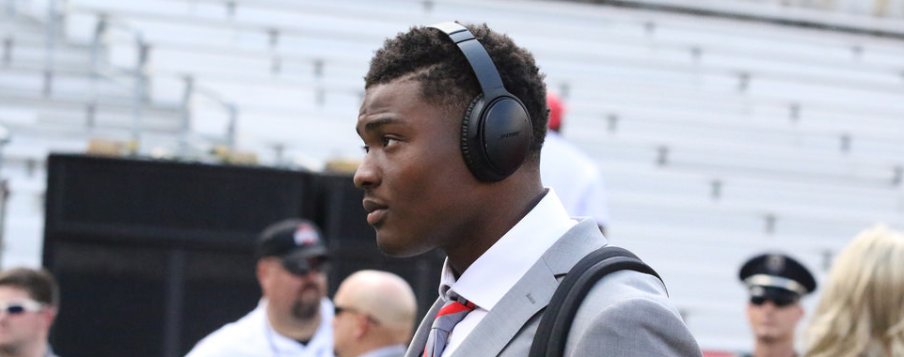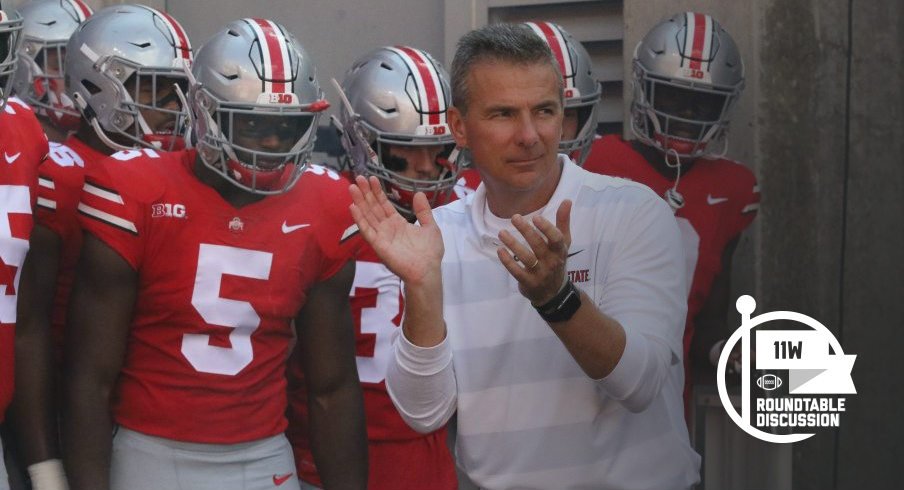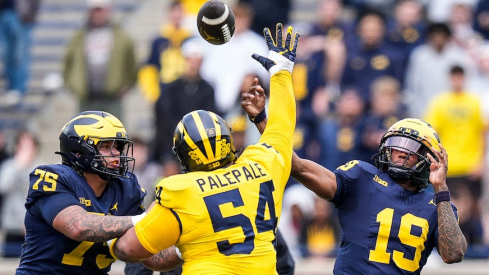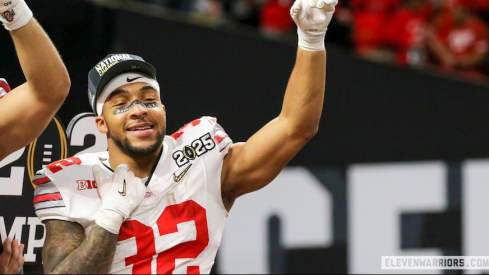After putting up 40+ points for the fifth time in six games during a 49-26 rout of Indiana last Saturday, the Buckeyes welcome Minnesota to the Shoe tomorrow for a noon kick.
The 23-point win wasn't without its warts as the Buckeye running game remained stagnant and the pass defense failed to quell its penchant for giving up big plays.
Can the good guys show progress in either of those facets? For thoughts on those queries and more, I welcome Dan Hope, Andy Vance and Jake Anderson from the 11W stable.
The state of the Buckeye rushing attack seems to be a chicken versus egg argument. The Buckeyes have averaged a dismal 3.2 yards per carry the last two weeks but that has come against a lot of stacked boxes and blitzes. What say you – is the running game struggling simply because of how defenses are scheming against the Buckeyes or is the offensive talent/scheme to blame?
Dan: I think it's a little bit of both. Urban Meyer said Thursday that Penn State did scheme against the Buckeyes to stop the run and force them to beat the Nittany Lions through the air, but that he felt the Buckeyes just didn't play well in the running game against Indiana. It's not because of a lack of talent: J.K. Dobbins and Mike Weber are two of the nation's best running backs, and all five offensive linemen have the ability to be dominant. They do have to find a way to get their running game going, particularly in short-yardage situations, where they no longer can rely on the quarterback power run that they had with J.T. Barrett over the past four years. They might need to try something different schematically or get more creative with their play calling. But I also think the concern of the running game is somewhat overblown, considering how effective the passing game has been.
Jake: In all honesty, it’s been both. The Nittany Lions’ front seven gave the Buckeyes’ fits all night as Penn State dared Haskins to throw the ball downfield. The line struggled mightily in Happy Valley and that continued against Indiana, even though Shareef Miller and Micah Parsons were not on the field. Dobbins failed to get anything going and the line struggled to get off the ball. Let’s hope this was due to the Penn State Hangover, as mentioned by Haskins, but the playcalling did not help much either. Haskins showed the nation why he never pulled the ball in inside zones at the start of the season.
In the last two games, Dobbins is averaging 3.2 yards per carry while Weber is putting up 5.5 yards per carry. Weber is also the superior third down pack and much better at pass protection. Maybe it’s time to rethink who the primary back is for Ohio State.
Andy: I’m somewhat baffled at this situation - Ohio State should be an absolute juggernaut on the ground, with one of the largest offensive lines in the country and two of the best running backs in the sport sharing the workload. It’s hard to pin things entirely on the line given how well they’ve acquitted themselves in pass protection, but for whatever reason (and Kyle Jones offers as good an explanation as I’ve read as usual) they’re just not getting the push up front we’re used to. I’ll grant that teams appear to be selling out against the run, and Dwayne Haskins and his stable of eager pass catchers are feasting on that through the air. I’m a firm believer that everything rests on the backs of the offensive line, so they’e got to step it up and start blowing guys off the ball and having their way with things in the rushing game.
Minnesota arrives in Columbus with the league’s fourth-best pass defense (196.8 ypg) and leads the conference in giving up just 15.0 first downs per game. Do the Gophers have any chance of slowing down Ohio State’s vaunted passing attack? What kind of day do you see Dwayne Haskins and the receivers having through the air?
Andy: Without Antoine Winfield, Jr., the Gophers’ secondary is missing its biggest playmaker. The linebackers are clearly a strength, but Haskins and the resurgent Zone Sicks Six have proven to be a most pleasant surprise and I don’t think they miss a step this weekend. After all, The Gophers allowed 314 yards through the air and four receiving touchdowns Saturday versus Iowa. It goes without saying that I don’t think of the Hawkeyes when I think of “elite passing teams,” and the stats bear that out: Iowa averages 243 yards per game (62nd nationally) to Ohio State’s 365 (3rd nationally). Ohio State’s receivers are going to eat Saturday, no question.
Jake: Without Winfield Jr., the Gophers will be a different team. Minnesota has played one full game without the star freshman and let up over 300 passing yards to Nate Stanley of Iowa. Granted, Stanley ripped Ohio State’s secondary apart last year, but it will not bode well for the Gophers on Saturday. Terell Smith and Jacob Huff are talented defensive backs, but they will simply be overwhelmed by the diverse receiving core of the Buckeyes.
Ohio State has mostly relied on short passes this season and I expect that trend to continue. Haskins has the ability to throw it deep, but their recent scheme suggests he will continue to distribute the ball to the athletes on the perimeter. This may be the best secondary the Bucks have seen since TCU, but a great gameplan that highlights Haskins’ ability will be the difference.
Dan: I don't foresee Minnesota slowing down Dwayne Haskins and Ohio State's passing attack. The Gophers' impressive early numbers are mostly a result of taking advantage of weak competition, and they gave up 314 passing yards and four passing touchdowns to Iowa last week. They've had to move pieces around in their secondary following Antoine Winfield Jr.'s season-ending injury, and Haskins and the Buckeyes are easily the best passing offense they've faced. Dwayne Haskins has already had four 300-yard games and four games with four or more passing touchdowns this season, and I like his chances of reaching both of those milestones again, or at least coming close, on Saturday.

Tyler Johnson is a legit receiving threat for the Gophers averaging over 80 yards per game, good for fourth-best in the Big Ten. How comfortable are you through six games that the Buckeye secondary can shut down an opposing team’s number one receiver?
Dan: The Buckeyes have allowed the leading receiver on each of the last four teams they've played to go for at least 77 receiving yards, with the last two (Penn State's K.J. Hamler and Indiana's Nick Westbrook) both going for more than 100 and scoring a touchdown, so completely shutting down an opponent's top receiver doesn't seem particularly likely at this point. Simply put, they don't have a cornerback like Denzel Ward this year who can lock down an opposing receiver for an entire game. The Gophers also have two talented freshman receivers in Rashad Bateman and Chris Autman-Bell, so it's not like the Buckeyes can focus all their efforts on Johnson, either. With that being said, Johnson isn't a burner; he's a skilled route-runner who handles contact well, so expect him to make some plays in the intermediate passing game, but the Buckeyes should be able to keep up with him as long as they don't make crucial mistakes.
Andy: How comfortable am I? Not comfortable at all, and that has nothing to do with Tyler Johnson and everything to do with the Buckeye secondary’s struggles this season. Losing first-round talent year after year and then losing DB whisperer Kerry Coombs to the NFL has taken its toll on The Unit Formerly Known as Best In America (TUFKABIA, for short). Ohio State is now allowing 222 yards per game through the air, ranking them No. 60 in the nation (rushing defense, for what it’s worth, isn’t much better at a 53rd-ranked 143 yards per game)… The good news, if there is any, is that the Silverish Bullets allow just 20 points per game, ranked No. 29 in the country. The big-play-prone “Break, don’t bend” style defense may not warm the cockles of your heart, but so far it’s kept opponents in check.
Jake: Tyler Johnson is a 6-foot-2 200-pound man that can take over games on the offensive end. He’s a great route-runner and is strong enough to break tackles from smaller players. As long as Ohio State continues to play man-to-man despite their corners’ inability to do so, great receivers will have the potential to go off. Kendall Sheffield will have the best chance to slow him down, but Johnson’s frame could bully Sheffield into submission.
Recently, Ohio State has always had a lockdown defensive back. Marshon Lattimore and Denzel Ward are the latest but the unit has failed to produce one this year. As it gets later in the season, it looks unlikely that a player will step up and transform into that man-to-man specialist the Buckeyes have had in the past. Ohio State will have to rely on getting to the quarterback to help out their back four because they will not be able to do the job on their own.
I found Athlon’s college football season preview mag on a table at the dentist office this week and had a good laugh at its B1G quarterback unit rankings in which Ohio State slotted fifth behind Penn State, Michigan State, Wisconsin, and Iowa. Good try, good effort. Anyway, through six games, rank the top three quarterbacks in the Big Ten and briefly defend your picks.
Jake: My list looks like this:
- Dwayne Haskins: Ohio State’s quarterback is in the middle of one of the greatest passing seasons in conference history. Not only is he flirting with the 2,000-yard mark midway through the season, but he is also posting a touchdown to interception ratio of over 6:1. Haskins does not make mistakes and forces his opponents to respect every spot on the field.
- Trace McSorley: What he lacks in passing production McSorley makes up for in rushing. The Penn State quarterback has not had an outstanding year thus far with just over 1,000 passing yards and 10 touchdowns through the air, but McSorley forces opponents to adjust their schemes. He can bounce out of the pocket and take off for 50 yards on any given snap and has accumulated over 400 rushing yards with 6 touchdowns. McSorley has the innate ability to will his team to victory and does so more often than not.
- Alex Hornibrook: Coupled with Jonathan Taylor, Hornibrook may not get the respect he deserves. Playing with a Wisconsin team built to run the ball, Hornibrook is tasked with managing the game. He averages 192.6 yards a game and has just seven touchdowns, but he completes 64% of his passes and has just two interceptions on the year. Shea Patterson, Brian Lewerke, and Peyton Ramsey could also compete for this spot, but Hornibrook’s decision making pulls him ahead. Pro Football Focus ranked him as the highest-graded quarterback in the conference through Week Six, cementing his place on this list. Hornibrook is not a flashy player with great stats, but he fills his role perfectly.
Dan: Going into the season, I ranked Penn State's Trace McSorley as the best quarterback in the Big Ten, but that's because he had two years of proven experience while Dwayne Haskins only had one half of significant game action. Now, though, I believe Haskins is the clear-cut top quarterback in the Big Ten. He has more than twice as many passing touchdowns and over 500 more passing yards than any other quarterback in the conference this year, and has emerged as perhaps one of the two best quarterbacks in the entire country.
McSorley isn't at the same level as Haskins as a passer, but he'd still be my No. 2 quarterback in the Big Ten, as he's also an excellent runner – as he proved against Ohio State – and a player who always seems to elevate his play in the biggest game and when the game is on the line. Michigan's Shea Patterson hasn't lived up to the preseason hype the same way Haskins has, but he still gets my vote as the third-best quarterback in the Big Ten, as he is the conference's most gifted passer not named Haskins and is coming off perhaps his best game as a Wolverine against Maryland, potentially setting him up for a breakout second half of the year.
Andy: I’m not sure which is funnier - Athlon’s blunder or Pro Football Focus’ continued efforts to paint Wisconsin’s Alex Hornibrook as the next John Elway. In the case of the latter, this feels like a case of overfitting the model, in which the analyst is trying really hard to “make fetch happen,” so to speak.
Haskins is clearly the No. 1 guy in the conference; he has pretty much owned the Big Ten Offensive Player of the Week award this season, and with good reason. Look at the data: he’s tops in the conference in completions (142), completion percentage (71.7%), passing yards (1,919), yards per attempt (9.7), touchdowns (25!) and passer rating (190.8). PFF can kibitz all they want about the depth of his passes (spoiler alert, his passing chart looks a lot like J.T. Barrett’s!), but he has nearly 2.5 times as many passing touchdowns as the next guy on the list and has only four picks to his name - most of which can be attributed to an error by the targeted receiver, if one wishes to pick nits.
After Haskins, put Shea Patterson, David Blough and Peyton Ramsey in a bag and go with whichever one falls out first. They’ve each got comparable numbers in terms of completion percentage, touchdowns and interceptions. Ramsey’s passer rating looks worse because he’s eaten a lot of turf by comparison to the other two guys, and thrown an extra pick or two, but he completes 67% of his passes and has 1,361 passing yards to his credit.
The B1G signal-caller I’m irrationally impressed with at the midway point in the season is Trace McSorley. That little wizard just makes things happen, as Buckeye fans saw firsthand two weeks ago. The two things that really kept Ohio State on its heels in Happy Valley were the Nittany Lions’ aggressive defense and McSorley’s ability to make a play happen seemingly out of thin air. He can sling the rock, and he has that uncanny escapability that Ohio State is missing from its own quarterback for the first time in forever.

Buckeye fans love to clown on Michigan but even with a loss to Notre Dame in week one that keeps looking better on paper and a tight win against Northwestern a few weeks ago, the Wolverines are sitting at 5-1 overall and 3-0 in league play. If Ohio State played Michigan in the Shoe this weekend, what would the point spread look like and would the Buckeyes cover? Support your pick.
Andy: Ohio State is No. 4 in the country according to S&P+ ratings… Michigan is No. 5. At home, that means Ohio State is probably a 3.5-point favorite right now, and I’d be hard-pressed to bet against them the way this rivalry has played out in the Harbaugh era. Breaking it down a little further, we’re talking about two teams that are really mirror images of one another: Ohio State is No. 3 in Offensive S&P+ and No. 27 in Defensive S&P+. The Wolverines are No. 25 and No. 2, respectively. See what I mean? Strength versus strength on both sides of the ball, according to the analytics. If The Game were played today, I think it would have the potential to be an All-Timer.
Dan: With Ohio State having home-field advantage, I think the point spread would be somewhere between 7.5 and 9.5 points, and I don't think the Buckeyes would cover. While the Wolverines haven't played as well as I thought they would this year, they're still one of the most talented teams in the country, and they typically make the rivalry game competitive. My prediction right now would be that Ohio State will extend its winning streak to seven years against Michigan, but not by more than a single touchdown.
Jake: Michigan has undoubtedly improved since their Week One loss, but the offense looks stagnant at times. Ohio State has proven its electric ability to score, but its defense has struggled for much of the year. The matchup would come down to the Buckeyes’ offense against the Wolverines’ defense, where Ohio State would simply be too much for them. The defensive line of Michigan is young and improving while their secondary is amongst the best in the Big Ten. The Buckeyes may struggle through the air, but a revitalized rushing attack would lead them to victory. I would pick Ohio State (-7.5) to cover at home in The Game.
Ohio State enters Saturday’s noon kick as a 29.5-point favorite in the Shoe. Will the Buckeyes cover against P.J. Fleck’s squad? Give us a final score and game MVP prediction.
Jake: Ohio State wins comfortably at 52-17. Weber makes his snaps count and goes for 100 yards rushing and 75 receiving to pull away from the Gophers in the third quarter.
Andy: Ohio State is 3-3 against the spread this season, failing to cover against TCU, Penn State and again last week versus Indiana. Minnesota, meanwhile, is 3-2 against the spread, but on a two-game losing streak. Fat lines like this one make me nervous, because I assume Ohio State will clear the benches in the second half, rather than letting Haskins take another shot at the single-game passing record for a second week in a row. With that in mind, I’m predicting a 49-21 finish, and once again Dwayne Haskins will be the Big Ten’s Offensive Player of the Week and the game’s MVP.
Dan: I think the Buckeyes will cover the spread against Minnesota. For all the concern that Ohio State fans seem to have this week over not winning in overly impressive fashion against Indiana, last week's game honestly went about exactly how I thought it would – after battling to a win over Penn State in a night game on the road, I always expected a letdown to some extent – and I expect the Buckeyes to come out of the gates stronger and play sharper this week. I also believe the Hoosiers are a better team than the Gophers. I'm predicting a final score of 52-20, but I expect the Buckeyes to be in control all the way in this game and be able to get their backups some playing time in the fourth quarter. My game MVP pick is Haskins, because it's simply hard to pick against the guy right now.


